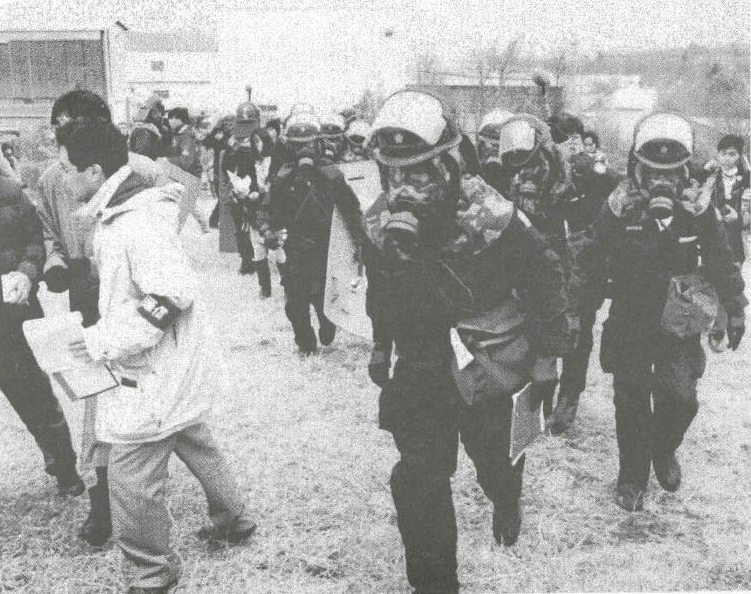It was during the morning rush hour on 20 March 1995.1 Atsushi Sakahara, an office worker in Tokyo, Japan, was riding on the subway on his way to work. Everything for him was as usual that morning, until he realized that something was changing in his body. He felt something wrong with his eyes. He was not able to focus on objects, which made him wonder whether he had forgotten to wash his contact lenses that morning. He moved to the next car, sensing something strange. It was the right decision, because there was a package wrapped in newspaper nearby him in that car that contained sarin gas.2

On that day, five subway trains in Tokyo were attacked at exactly the same time. The attackers were members of Aum Shinrikyo or Aum Supreme Truth, which is a Japanese religious group founded by Shoko Asahara. They released highly poisonous sarin gas on each train, resulting in innumerable numbers of wounded people.3 Atsushi became one of these victims.
His eyes still felt strange even after he left the car to go to the next one. The strange feeling was because of the sarin gas that he breathed in, despite its small amount. At the moment he began to feel his eyes burn, he looked back to the other side of the door he just left; he saw something. One of the men inside the other car started going into fits. That convinced him that it was indeed dangerous to be there, although he didn’t know actually what was happening. Actually, by that time a number of people had already been exposed to the gas, and some of them stood in great danger. He immediately got off the train before his planned stop, and took a taxi to go to his office. However, his sight remained blurred, as if he were seeing everything through a filter. The next thing he did, which may have saved his life, was to see a doctor instead of continuing to work.4 He judged things correctly and acted calmly.

Fortunately, his injury was not a matter of life and death. Nevertheless, he still suffered from its after effects and some psychical trauma, which totally changed the rest of his life. Sarin is a nerve gas with high lethal potential that causes a variety of secondary diseases. It brings about, for example, blurred vision, eye pain, nausea, headache or dyspnea. Then, many of the victims continue to suffer from sicknesses such as headache or eye symptoms long after the attack.5 Atsushi had dysgraphia, fatigue, numbness of arms and legs, and blackouts subsequent to the attack. And the miserable experience deeply damaged his mind. Indeed, many other people also had mental problems, even after their physical problems were completely healed. Sometimes it is called PTSD, or post-traumatic stress disorder, and the patients suffer from nightmares, dizziness, palpitation, or insomnia.6
It was not easy at all for Sakahara to get over these hardships, after being involved in this act of terrorism. However, he succeeded in finding his own solution. He made movies about his experiences as a form of catharsis: a way to remove damaged feelings by emitting them. He retired his job in Tokyo and went to the United States. He then helped to create a short movie called Bean Cake. The film won the Palme D’Or at the Cannes Film Festival in 2001. After that, he returned to Japan and took up a career as a film maker. And currently he is working on his own documentary film on Aum Shinrikyo, the religious cult that was responsible for the sarin gas attack that brought him and others so much pain. He never gives in to his misfortune, and he refrains from hatred against his attackers. In his interview with Japanese media, he said, “I want to believe in humanity. Even if people kill each other in the name of religion, even if people kill each other in the name of a country, or even if people kill each other in the name of race, I still want to believe in humans.”7

The Tokyo sarin gas attack became the first large-scale terrorist chemical gas attack in the world resulting in 12 fatalities and 5,500 injured.8 Many of them are suffering from the effects of the attack even now, more than twenty years after it happened. Atsushi Sakahara’s upcoming film will help a lot of people to know, remember, and tell the next generation not only about this tragedy, but also about people’s power to overcome such painful experiences.
- Patterns of Global Terrorism 1995, 1996, s.v. “Year in Review.” ↵
- “Survivor’s tale: The Tokyo sarin gas attack 20 years later,” Newswires, 2015, EBSCOhost (accessed September 8, 2018). ↵
- Patterns of Global Terrorism 1995, 1996, s.v. “Asia Overview.” ↵
- “Survivor’s tale: The Tokyo sarin gas attack 20 years later,” Newswires, 2015, EBSCOhost (accessed September 8, 2018). ↵
- Tetsu Okumura, et. al., “Report on 640 Victims of the Tokyo Subway Sarin Attack,” Annals Of Emergency Medicine 28 (1996): 131. ↵
- Toshiyuki Ohtani, et al., “Post-traumatic stress disorder symptoms in victims of Tokyo subway attack: a 5-year follow-up study.” Psychiatry & Clinical Neurosciences58, no. 6 (2004): 626; “Survivor’s tale: The Tokyo sarin gas attack 20 years later,” Newswires, 2015, EBSCOhost (accessed September 8, 2018). ↵
- “Survivor’s tale: The Tokyo sarin gas attack 20 years later,” Newswires, 2015, EBSCOhost (accessed September 8, 2018). ↵
- “Asia Overview,” Patterns of Global Terrorism 1995(1996): 3 ↵



28 comments
Lamont Traylor
I remember hearing about this attack when I was in high school and it reminds me about all of the other terrorist attacks that have occurred all over the world and it is just terrible that people will really do things like that. I will never understand what goes through people’s minds when they think to themselves that it would be a good idea to kill a bunch of innocents.
Katherine Watson
To think of Atsushi Sakahara had not reacted any sooner, he may not be here to tell his story and the effects it has had on his entire life. The Aum Shinrikyo had this plan thoroughly thought out with the intentions to hurt may people, and their mission was accomplished as 12 people lost their lives and 5,500 had/have to live with the aftermath effects. But what I am sure they did not anticipate was for someone like Sakahara to take their experience and turn it into a public awareness movement for the effects that these mass terrorist attacks can have on everyday people. I’m delighted that he has found a way to turn what happened to him into a semi-positive experience by trying to make sure that his situation does not happen to anyone else.
Sarah Nguyen
This was an interesting article, and the author did a great job in educating the audience about the first large scale chemical gas attack. I liked how you connected with one person and followed up on his story regarding what he felt during the attack, and how he was doing afterwards. I wish there had been a little extra regarding the Aum Shinrikyo’s motive though, and actions taken by the government after this.
Christopher Hohman
Nice article. It is a terrible thing what happened to this man. I am glad that he got off the train in time. Still so many people, twelve, did not. It is terrible that people do this to each other. Like this man said though, I still like to believe in humanity too. Even if we do terrible things to each other. I am glad this man found an outlet in his films. It probably helped him cope with his PTSD and made him feel good about himself. I hope the new documentary serves its purpose well, and that the Japanese do not forget this terrible attack
Valeria Perez
I had never heard about these gas attacks before this article. Why would the Aum Shinrikyo do this? What happened to them afterward? It is horrible to hear that the people exposed to the gas are still affected by the incident. I admire Atsushi determination to keep the incident relevant and to show the world that though he has suffered because of this he still goes on and does something about it.
Madison Guerra
Before reading the article i had never heard of the sarin gas attacks. I was very interesting to read about, but it was sad to know how many peoples lives were negatively affected by this act of terrorism. I will never understand how being can be so heartless and cruel to do these things and then blame it on religion. It is disgusting.
Adrian Cook
It was smart for Atsushi to leave that train car before anything worse could’ve happened to him and to immediately receive medical attention. These attacks were out of hate and affected many people differently. These symptoms are no joke and can take a persons life very easily. Atsushi is now gaining from his experience and benefiting in how own health by making these movies. I’m glad he was able to overcome such a huge obstacle.
Martina Rodriguez
I have to admit that I had never heard of the sarin gas attacks before now. However I was shocked to read that Atsushi went to work regardless of how ill he was feeling. At least he went to the doctor afterwards, but talk about a dedicated employee. I never realized making movies was an outlet for PTSD but I’m happy that such an art helped him cope with the aftereffects of the experience.